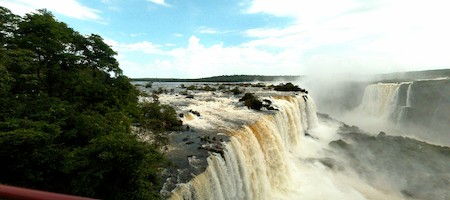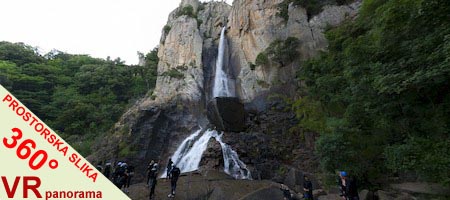What is a waterfall...?
It is not easy to define what a waterfall is. Basically, every falling
water is a waterfall. Height isn't the most important, the quantity of
falling water also counts.
Subjective point of view: "The most important are our feelings, when
we are near waterfall...are they soothing, romantic, respectful ... ?
"
- Waterfall is stream or river which flows on slope which has more than 45
degrees - 100% inclination.
- Fall must be equal or higher than 5 m (there are also exceptions);
- Distance between two stages of waterfall can be only 5 m (10 m)- 16 feet
( 32 feet), otherwise there are two waterfalls;
I. Slovenian waterfalls and their height Worldwide waterfalls are divided in two basic groups by their height
-
Low waterfalls - cascades
-
Great waterfalls - cataracts (beside their height,
the water flow is also very important)
The only real cataract in Slovenia might be waterfall Boka which height is 144 m (468 feet), wide ( 20 m - 66 feet) and water flow
is up to 100 cubic metre per second - depended of the season. Cataract
should be Waterfall Savica (78 m - 255 feet) and Waterfall Peričnik (52 m - 170 feet). Both have very strong permanent water flow, but they
are not wide enought.
Waterfalls (Slovenian terminology) are divided in six
groups by their height:
-
A. White waters
-
B. "Waterfalls" with height from 1 m to 3 m ( 3 to
9 feet) are named "jumpers"
-
C. "Waterfalls" with height from 3 to 5 m (9 to 16
feet) are named "Small plungers" or "little waterfalls"
-
D. Low waterfalls : height from 5 to 15 m (16 to
48 feet)
-
E. Medium height waterfalls : height from 15 to 30
m ( 48 - 96 feet)
-
F. Height waterfalls : height more than 30 m ( 96
feet and more)
*suggestions:
-
D. Low waterfalls : height from 5 to 30 m (16 to
96 feet)
-
E. Medium height waterfalls 30 to 79 m ( 96 to 295
feet)
-
F. Hight waterfalls : height more than 80 m ( 295
feet and more). I have changed the limit from previous 90 m to 80 m because
of the Gregorčič waterfall.
In Slovenia are many permanent stages of waterfalls with total height up
to 1000 m.
Examples:
-
Waterfalls of Globišča - total height of waterfalls is over 400 m, but the highest Waterfall Sapet
has height only about 60 m. Somewhere else would be said that here is only
one waterfall with height over 400 m.
- The same is with the Waterfalls of Fratarica .
The highest waterfall -Veliki Drsnik is height 112 m, but total height
of all waterfalls is almost 1 Km. (1000 m)
-
Waterfalls of Kloma - total height over 700 m. The highest fall
of Kloma has height o128 m.

II. Waterfalls are divided in two basic
geologic groups
A. Constructive waterfalls (Waterfalls with growth),
Usually tufa waterfalls
B. Destructive waterfalls (Waterfalls which are
lowering),
- Excavating waterfalls
Waterfalls because of hard crockery among soft
one,
Tectonic waterfalls (where are tectonic break
zones),
Hooked waterfalls (usually on the edges of valleys),
Barrage waterfalls (waterfalls which are falling
from huge rocks)
- Withdrawing waterfalls
Waterfalls with withdraw (such waterfalls are
slowly moving up to the steam)
World famous example are Niagara Falls or Waterfalls
of Iguassu River .
III. Waterfalls and the shape
Some waterfalls could change their shape in a guite short period. Such
a change usually isn't perceivable during a human life.
After many approaches to the waterfalls and with the help of the literature
from round the world, I have put waterfalls in sixteen basic categories:
(Waterfall could have many shape charasteristic, which can be combined
during its flow. Each waterfall could be in a few categories) ...
-
Free falling waterfalls (plunge = waterfall with
free-falling water, without coming into contact with the rock wall), examples: Parabola Rinka
-
Fans (waterfall, which are narrow on the top nad
wide on the bottom), examples: Gorejca Lomščiski
slap
-
Waterfalls with the slide flow on the rock slope
(slope must be more than 45 degrees), example: Predelski
slap Nemiljski
šum ,
-
Waterfalls in the steep channel, examples: Slap
Igla Zgornji desni slap Belega
potoka Slap Juliana,
-
Waterfalls with one stage, example:The
lower waterfall of Mlinarica Zalski
slap,
-
Waterfalls with two or more stages falling from one
to the eachother (distance between two strages may be less than 10 m otherwise
there are two waterfalls, examples: Globišča Jurežev
slap
-
Cascades, like waterfalls with more stages, but much
lower - usualy tufa waterfalls, example: Waterfals of Krka
river Zgornji
Tišenpoljski slap,
-
Waterfalls with narrow jet of water, waterfalls with
the narrow stream, example : Peričnik
-
Waterfalls with the wide stream, example: Boka Stegovniški
slap,
-
Waterfalls with one stream, example: Grmečica Tominčev
slap
-
Waterfalls with two or more streams, examples: Slap
Savica Drugi Davški
slap
-
Segmented waterfalls - waterfalls like white waters
but much more higher, examples: Nadiško
šumelišče Slapišče v Dolžanovi
soteski
-
Waterfalls hidden from the back of the fault (rock
wall) (like waterfalls in the channel, but hidden from the back of the
rock wall, very rare type of waterfall), examples: majority of Waterfalls
of Šumnik Waterfall
Egg
-
Waterfalls which flow trought steep tunel or under
natural bridge; examples: right stream of Savica Veliki
Možniški slap
-
Punchbowl waterfalls (falling water enters a pool),
example: Poševni
slap Zaročenca,
-
Horseshoe waterfalls (like waterfalls with the wide
stream, but with the shape U), example: Iguassu
River .
IV. Waterfalls by the drainage
-
Waterfalls below the spring (waterfall which is also
spring of the river or stream, usualy karst vent-holes, examples: Boka Savica Nadiško
Šumelišče and some not permanent waterfalls but also interesting : Hubelj spring near Ajdovščina, Govic
That were only permanent waterfalls ( full time drainage). In spring, when
snow is melting there are also many plunge waterfalls with height up to
300 m.
About Slovenian waterfalls
|
 Slap
Slap
 Watefall
Watefall


